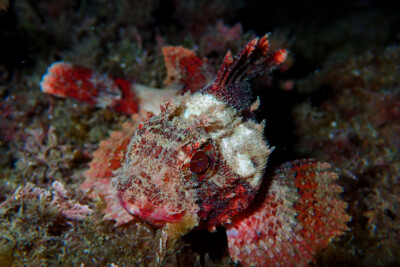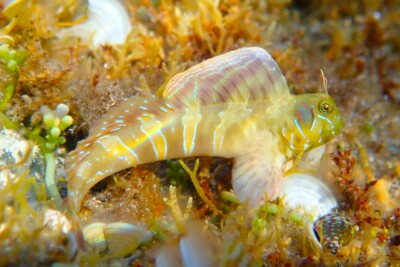ringneck blenny
| Family | Blenniidae |
|---|---|
| Genus | Parablennius |
| IUCN category (World) | LC |


Introduction
Parablennius pilicornis, commonly known as ringneck blenny, is a salt water fish.
This sheet is currently being prepared. The texts currently proposed come from our data model or are being drafted. To request priority for this content, you can write to us HERE.
Who is it?
Morphology
-
Average size8 cm
-
Maximum size13 cm
-
ShapeRectangular
-
Mimicrystone
-
Patternmottling
-
Average size8 cm
-
Maximum size13 cm
-
ShapeRectangular
-
Mimicrystone
-
Patternmottling
How to recognize This fish ?
The ringneck blenny measures between 8 and 13 cm. This fish is bicolore with a predominantly jaune, marron, blanc and beige body. The also has marron mottling.
Behaviour & Life cycle
-
dietherbivorous
-
Sociabilitysolitary
-
territorialYes
-
Way of livingdiurnal
The ringneck blenny is a fish solitary naturally found in the vegetation. This species is herbivorous .
In a constant quest for dominance, the dominant males of this species cannot stand each other. The battle between two individuals can be intense and violent. It will result in the submission and sometimes even death of one of the protagonists.
Reproduction
-
Reproductionovipare qui pond sur substrat caché
The ringneck blenny is a fish ovipare qui pond sur substrat caché.
Harmless species
This species does not represent any particular threats to humans when encountered in its natural environment.
Origin and distribution

What is its habitat?
Natural environment characteristics
-
Depth0 - 25 m
Biotope presentation
The ringneck blenny is most often found at a depth between 0m and 25m. However, it is not impossible to find this species at other depths.
Species of the same biotope
Fishkeeping
Not recommended
We do not recommend keeping this species in an aquarium. It has unpredictable needs which, if not met, generate significant stress, potentially leading to a shorter life expectancy, an interruption of its growth or the development of pathogens.
To go further
Sources & Contributions
Participation & Validation
The Fishipedia team and specialist contributors are committed to providing high-quality content. However, although the information comes from scientific sources or testimonials from specialists, the cards may contain inaccuracies.

Adrien Falzon

Benoit Chartrer
Translation
Translation done with the valuable contribution of our translators, who make this information available to a wider audience. We sincerely thank them for their commitment.
Scientific partners
Tags
#Blenniidae
#Parablennius
#Faille
#zone de ressac
#Cap de Magellan pacifique
#Gulf of Mexico
#mer d'Oman
#Caribbean Sea
#Mediterranean Sea
#Red Sea
#Atlantic Ocean: North Coast of Brazil
#Temperate Eastern Atlantic Ocean
#Gough Island
#Saint Helena
#Northwest warm temperate Atlantic Ocean
#Southwest warm temperate Atlantic Ocean
#Eastern tropical Atlantic Ocean
#Southwest Tropical Atlantic Ocean
#western Indian Ocean
#Corsica
#Canary Islands
#Sardinia
#Sicily
Species of the same family
Same genus
Species of the same biotope































